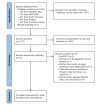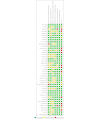Effectiveness of Using Virtual Reality-Supported Exercise Therapy for Upper Extremity Motor Rehabilitation in Patients With Stroke: Systematic Review and Meta-analysis of Randomized Controlled Trials
- PMID: 35723907
- PMCID: PMC9253973
- DOI: 10.2196/24111
Effectiveness of Using Virtual Reality-Supported Exercise Therapy for Upper Extremity Motor Rehabilitation in Patients With Stroke: Systematic Review and Meta-analysis of Randomized Controlled Trials
Abstract
Background: In recent years, efforts have been made to implement virtual reality (VR) to support the delivery of poststroke upper extremity motor rehabilitation exercises. Therefore, it is important to review and analyze the existing research evidence of its effectiveness.
Objective: Through a systematic review and meta-analysis of randomized controlled trials, this study examined the effectiveness of using VR-supported exercise therapy for upper extremity motor rehabilitation in patients with stroke.
Methods: This study followed the PRISMA (Preferred Reporting Items for Systematic Reviews and Meta-Analyses) guidelines. The CINAHL Plus, MEDLINE, Web of Science, Embase, and Cochrane Library databases were searched on December 31, 2021. Changes in outcomes related to impairments in upper extremity functions and structures, activity limitations, and participation restrictions in life situations from baseline to after intervention, after intervention to follow-up assessment, and baseline to follow-up assessment were examined. Standardized mean differences (SMDs) were calculated using a random-effects model. Subgroup analyses were performed to determine whether the differences in treatment outcomes depended on age, stroke recovery stage, VR program type, therapy delivery format, similarities in intervention duration between study groups, intervention duration in VR groups, and trial length.
Results: A total of 42 publications representing 43 trials (aggregated sample size=1893) were analyzed. Compared with the control groups that used either conventional therapy or no therapy, the intervention groups that used VR to support exercise therapy showed significant improvements in upper extremity motor function (Fugl-Meyer Assessment-Upper Extremity; SMD 0.45, 95% CI 0.21-0.68; P<.001), range of motion (goniometer; SMD 1.01, 95% CI 0.50-1.52; P<.001), muscle strength (Manual Muscle Testing; SMD 0.79, 95% CI 0.28-1.30; P=.002), and independence in day-to-day activities (Functional Independence Measure; SMD 0.23, 95% CI 0.06-0.40; P=.01, and modified Rankin Scale; SMD 0.57, 95% CI 0.01-1.12; P=.046). Significant subgroup differences were observed in hand dexterity (Box and Block Test), spasticity (Ashworth Scale or modified Ashworth Scale), arm and hand motor ability (Wolf Motor Function Test and Manual Function Test), hand motor ability (Jebsen Hand Function Test), and quality of life (Stroke Impact Scale). There was no evidence that the benefits of VR-supported exercise therapy were maintained after the intervention ended.
Conclusions: VR-supported upper extremity exercise therapy can be effective in improving motor rehabilitation results. Our review showed that of the 12 rehabilitation outcomes examined during the course of VR-based therapy, significant improvements were detected in 2 (upper extremity motor function and range of motion), and both significant and nonsignificant improvements were observed in another 2 (muscle strength and independence in day-to-day activities), depending on the measurement tools or methods used.
Trial registration: PROSPERO CRD42021256826; https://tinyurl.com/2uarftbh.
Keywords: meta-analysis; rehabilitation; stroke; upper extremity; virtual reality.
©Jiayin Chen, Calvin Kalun Or, Tianrong Chen. Originally published in the Journal of Medical Internet Research (https://www.jmir.org), 20.06.2022.
Conflict of interest statement
Conflicts of Interest: None declared.
Figures
References
-
- Johnson W, Onuma O, Owolabi M, Sachdev S. Stroke: a global response is needed. Bull World Health Organ. 2016 Sep 01;94(9):634–A. doi: 10.2471/BLT.16.181636. http://europepmc.org/abstract/MED/27708464 BLT.16.181636 - DOI - PMC - PubMed
-
- GBD 2016 Lifetime Risk of Stroke Collaborators. Feigin VL, Nguyen G, Cercy K, Johnson CO, Alam T, Parmar PG, Abajobir AA, Abate KH, Abd-Allah F, Abejie AN, Abyu GY, Ademi Z, Agarwal G, Ahmed MB, Akinyemi RO, Al-Raddadi R, Aminde LN, Amlie-Lefond C, Ansari H, Asayesh H, Asgedom SW, Atey TM, Ayele HT, Banach M, Banerjee A, Barac A, Barker-Collo SL, Bärnighausen T, Barregard L, Basu S, Bedi N, Behzadifar M, Béjot Y, Bennett DA, Bensenor IM, Berhe DF, Boneya DJ, Brainin M, Campos-Nonato IR, Caso V, Castañeda-Orjuela CA, Rivas JC, Catalá-López F, Christensen H, Criqui MH, Damasceno A, Dandona L, Dandona R, Davletov K, de Courten B, deVeber G, Dokova K, Edessa D, Endres M, Faraon EJ, Farvid MS, Fischer F, Foreman K, Forouzanfar MH, Gall SL, Gebrehiwot TT, Geleijnse JM, Gillum RF, Giroud M, Goulart AC, Gupta R, Gupta R, Hachinski V, Hamadeh RR, Hankey GJ, Hareri HA, Havmoeller R, Hay SI, Hegazy MI, Hibstu DT, James SL, Jeemon P, John D, Jonas JB, Jóźwiak J, Kalani R, Kandel A, Kasaeian A, Kengne AP, Khader YS, Khan AR, Khang YH, Khubchandani J, Kim D, Kim YJ, Kivimaki M, Kokubo Y, Kolte D, Kopec JA, Kosen S, Kravchenko M, Krishnamurthi R, Kumar GA, Lafranconi A, Lavados PM, Legesse Y, Li Y, Liang X, Lo WD, Lorkowski S, Lotufo PA, Loy CT, Mackay MT, Abd El Razek HM, Mahdavi M, Majeed A, Malekzadeh R, Malta DC, Mamun AA, Mantovani LG, Martins SC, Mate KK, Mazidi M, Mehata S, Meier T, Melaku YA, Mendoza W, Mensah GA, Meretoja A, Mezgebe HB, Miazgowski T, Miller TR, Ibrahim NM, Mohammed S, Mokdad AH, Moosazadeh M, Moran AE, Musa KI, Negoi RI, Nguyen M, Nguyen QL, Nguyen TH, Tran TT, Nguyen TT, Anggraini Ningrum DN, Norrving B, Noubiap JJ, O’Donnell MJ, Olagunju AT, Onuma OK, Owolabi MO, Parsaeian M, Patton GC, Piradov M, Pletcher MA, Pourmalek F, Prakash V, Qorbani M, Rahman M, Rahman MA, Rai RK, Ranta A, Rawaf D, Rawaf S, Renzaho AM, Robinson SR, Sahathevan R, Sahebkar A, Salomon JA, Santalucia P, Santos IS, Sartorius B, Schutte AE, Sepanlou SG, Shafieesabet A, Shaikh MA, Shamsizadeh M, Sheth KN, Sisay M, Shin KJ, Shiue I, Silva DA, Sobngwi E, Soljak M, Sorensen RJ, Sposato LA, Stranges S, Suliankatchi RA, Tabarés-Seisdedos R, Tanne D, Nguyen CT, Thakur JS, Thrift AG, Tirschwell DL, Topor-Madry R, Tran BX, Nguyen LT, Truelsen T, Tsilimparis N, Tyrovolas S, Ukwaja KN, Uthman OA, Varakin Y, Vasankari T, Venketasubramanian N, Vlassov VV, Wang W, Werdecker A, Wolfe AD, Xu G, Yano Y, Yonemoto N, Yu C, Zaidi Z, El Sayed Zaki M, Zhou M, Ziaeian B, Zipkin B, Vos T, Naghavi M, Murray CJ, Roth GA. Global, regional, and country-specific lifetime risks of stroke, 1990 and 2016. N Engl J Med. 2018 Dec 20;379(25):2429–37. doi: 10.1056/NEJMoa1804492. http://europepmc.org/abstract/MED/30575491 - DOI - PMC - PubMed
Publication types
MeSH terms
LinkOut - more resources
Full Text Sources
Medical



